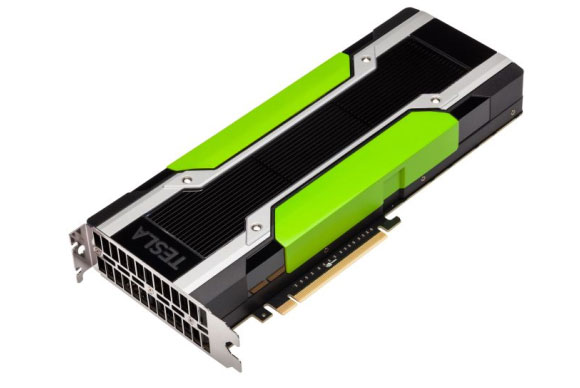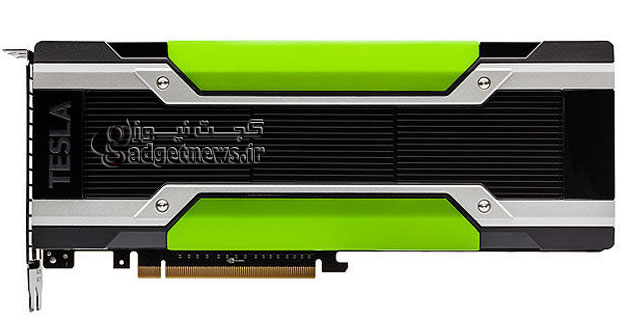انویدیا از جدیدترین نسل کارتگرافیکهای خود برای کامپیوترهای سرور و محاسباتی پرده برداری کرد. این کارت گرافیک بر اساس آخرین معماری انویدیاست و 4,992 هسته آن به همراه 24 گیگابایت حافظه، انجام هر گونه محاسبات سنگین گرافیکی را بر عهده میگیرد.
حالا که انویدیا با گرافیکهای سری 900 و 900M خود تکانی به دنیای کامپیوترهای دسکتاپ داده، نوبت به دنیای ابرکامپیوترها رسیده است.
انویدیا دیروز از کارت گرافیک Tesla K80 رونمایی کرده که با دو پردازنده گرافیکی، سریعترین محصول تولیدی این شرکت تا امروز محسوب میشود. K80 بر اساس تکنولوژی مکسول به کار رفته در کارتگرافیکهای جیفورس انویدیا تولید شده، اما علاوه بر افزایش چشمگیر حافظه، بهینه سازی های دیگری نیز بر روی آن انجام شده است.
از این کارت گرافیک میتوان در شرکتهای مهندسی و به قصد خلق مدلهای گرافیکی و یا در شبیه سازی های میادین نفتی و گازی استفاده کرد. تسلا همچنین حضور پررنگی در سرورهای شرکتهای بزرگ دنیا دارد.
تسلا K80 قادر است سرعتی معادل 8.74 ترافلاپس را تأمین کند، در حالی که جیفورس جیتیاکس 980 توانایی سرعتی 5 ترافلاپسی دارد. این کارت گرافیک همچنین دارای پهنای باند حافظه دوبرابری نسبت به نسل قبلیاش، K40 میباشد که تقریبا یک سال پیش معرفی شد.
K80 شامل دو چیپ میشود که در مجموع این کارت گرافیک فوق قدرتمند را دارای 4,992 هسته پردازشی، 24 گیگابایت حافظه GDDR5 و پهنای باند 480GBps میکند.

انویدیا در این محصول تکنولوژی GPU Boost را نیز به خدمت گرفته که با افزایش سرعت پردازش نتیجه بهتری را برای کاربران به ارمغان میآورد. شرکتهایی چون اچپی، دل، کوانتا و کری از K80 در سرورهای خود استفاده خواهند کرد.
انویدیا پیشتر خبر داده بود که در سال 2016 کارت گرافیکهای سریع تری را بر پایه معماری پاسکال به بازار وارد میکند. این چیپ ها بر اساس گذرگاههای NV-Link کار میکنند که سرعتی 5 برابری را نسبت به پیسیآی اکسپرس کنونی تأمین میکنند.
منبع : pcwolrd
Meet the Tesla K80: Nvidia's most powerful graphics card yet has an insane 24GB of RAM
Meet the Tesla K80: Nvidia's most powerful graphics card yet has an insane 24GB of RAM
nvidia’s PC graphics chips may draw all the attention, but supercomputing chips are driving the company’s GPU technology ahead.
The company on Monday announced an updated Tesla K80 graphics card, which is its fastest graphics product to date. Tesla is used in some of the world’s fastest supercomputers to solve pressing scientific questions.
The K80 is based on technology similar to that used in GeForce PC graphics cards, but with some memory and throughput tweaks. The graphics card can be used by engineering companies to simulate visual models, or by oil and gas companies for geological research to find the best drilling sites. Tesla has also been used in servers to deliver virtual desktops to remote clients.
The K80 delivers 8.74 teraflops of single-precision performance compared to 5 teraflops on Nvidia’s flagship GeForce GTX 980 desktop graphics card. The K80 also has two times the performance and memory bandwidth of its predecessor, the K40, which was announced around the same time last year.
In 2016, Nvidia is promising even faster graphics products based on Pascal architecture, a new on-chip communication technology. Through a new interconnect called NV-Link. GPUs will be able to exchange data faster, which will facilitate better performance. Nvidia says NV-Link is five times faster than the PCI-Express 3.0 interconnect, which is used in most servers and PCs.
Nvidia’s Tesla is one of many server accelerators available. Intel sells the Xeon Phi chip, while Advanced Micro Devices offers FirePro cards for servers and workstations. Software needs to be written specifically to take advantage of these processors, and Nvidia offers its CUDA parallel programming framework for Tesla.
One knock on GPUs has been the amount of power they chew up in processing. As a result, they have to be used for specific tasks.
The K80 chip is broken up into two graphics processors, which share the balance of processing. Combined, the chip has 4,992 processing cores, 24GB of GDDR5 memory and memory bandwidth of 480GBps. A technology called GPU Boost can kick up performance for specific applications in bursts to deliver better results.
Hewlett-Packard, Dell, Quanta and Cray will use the K80 GPUs in servers. Servers from HP and Dell will run on Intel’s Xeon CPUs.
Dell’s PowerEdge C4130 is a 1U server that looks more like an appliance and will be able to accommodate up to two K80 cards. A number of C4130 servers could be used as cabinets to build a supercomputer, said Jimmy Pike, chief architect for Dell’s enterprise solutions group.
 گجت نیوز آخرین اخبار تکنولوژی، علم و خودرو
گجت نیوز آخرین اخبار تکنولوژی، علم و خودرو 







